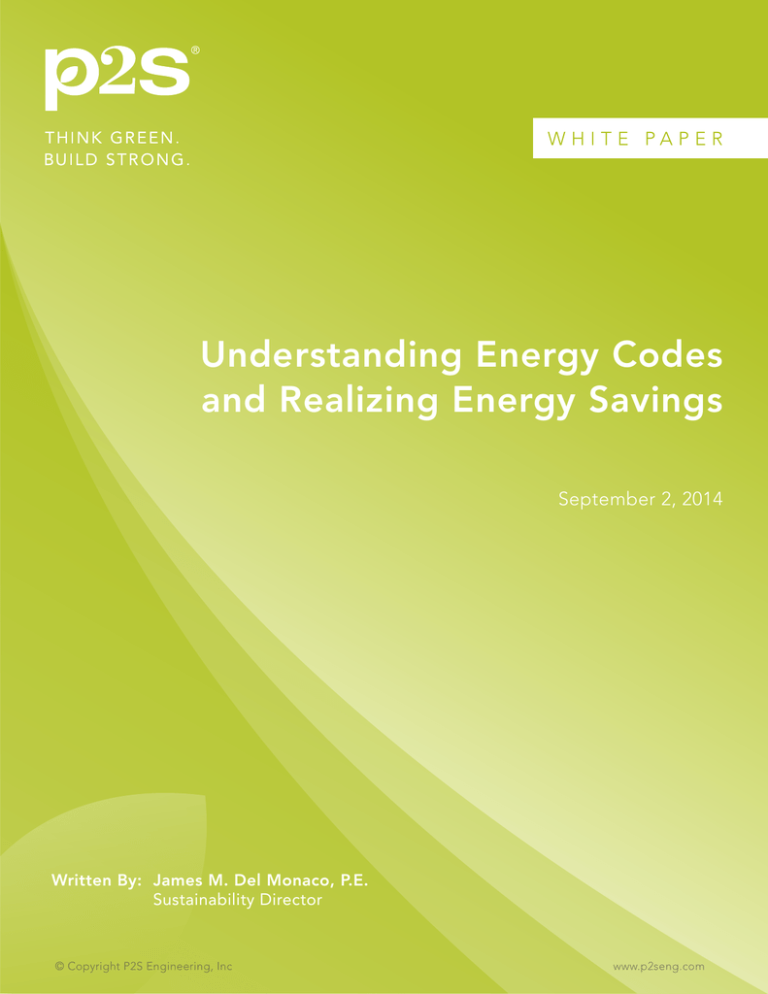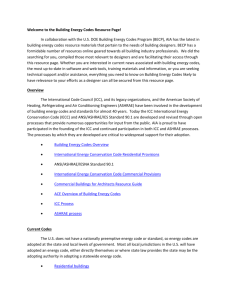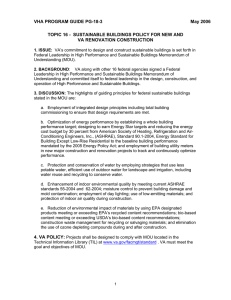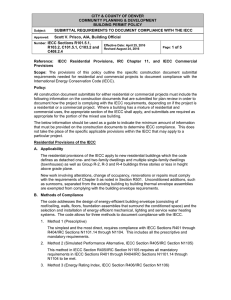Understanding Energy Codes and Realizing
advertisement

W H I T E PA P E R Understanding Energy Codes and Realizing Energy Savings September 2, 2014 Written By: James M. Del Monaco, P.E. Sustainability Director © Copyright P2S Engineering, Inc www.p2seng.com Understanding Energy Codes and Realizing Energy Savings According to the DOE, in 2010 the primary energy consumption of the United States was nearly 19% of the world’s total primary energy use. Of that energy use, approximately 39% is from commercial and residential buildings. As such, the further development of energy codes provides an opportunity to greatly reduce the energy use not only in this country, but also the world. In response to the energy and economic crisis of the early 1970s, the United States began the development of building energy codes and standards for commercial and residential buildings. The first standard was developed by the American Society for Heating Refrigeration & Air Conditioning Engineers (ASHRAE) in 1975 and was titled ASHRAE Standard 90-75 “Energy Conservation in Buildings.” Also in 1975, Congress passed the Energy Policy and Conservation Act, which first recommended that 90-75 be adopted as a uniform national standard. A second national energy standard, MCEC 1977, was developed by the Council of American Building Officials (CABO) in 1977 and soon became the Model Energy Code 1983. CABO released updated versions until 1998 when the International Code Council (ICC) developed the International Energy Conservation Code. (IECC). Both ASHRAE and the ICC continue to develop these standards and codes on a continuous maintenance program to address the latest trends and development in energy conservation. The next major development of energy codes in the United States came about from the adoption of The Energy Policy Act of 1992. It required that the Department of Energy (DOE) become actively involved in the process of developing and implementing the latest energy codes and standards. One of the DOE’s responsibilities included determining © Copyright P2S Engineering, Inc whether the latest energy standards actually save energy. The DOE informs the states if the new versions save energy and requires that they implement the latest approved standard or an equivalent standard. In the United States, the adoption and enforcement of such standards is left up to the state and local jurisdictions. Some states, such as California, can choose to develop their own energy codes. California has developed its own energy standard, which is adopted as the California Energy Code (CEC), Title-24 Part 6. Energy codes today Today’s energy codes address energy use and efficiency of both commercial and residential buildings. Typical components addressed include the building envelope (walls, roof, glazing, etc.), mechanical systems, service water heating, indoor and outdoor lighting, etc. The codes address such things as minimum efficiency of equipment/ components and control features, among others. The codes also distinguish various requirements based on climate zone. For example, under the 2010 CEC, a building near Lake Tahoe would be required to provide higher performance glazing than the same project near Long Beach, which has a milder climate. www.p2seng.com Understanding Energy Codes and Realizing Energy Savings According to the DOE, in 2010 the primary energy consumption of the United States was nearly 19% of the world’s total primary energy use. Of that energy use, approximately 39% is from commercial and residential buildings. As such, the further development of energy codes provides an opportunity to greatly reduce the energy use not only in this country, but also the world. But do energy codes really save energy? minimum building for the 2006, 2009, and 2012 IECCs as well as the 2004, 2007, and 2010 ASHRAE 90.1 standards to understand the energy use and energy cost for each of these prototype buildings. The study analyzed various building types in multiple climate zones throughout the United States utilizing energy modeling software. Figure 1 provides a quick overview of the findings of the study which show that the newer energy codes are more stringent than previous versions and do result in energy savings. A study published in August 2013 by the Pacific Northwest National Laboratory (PNNL) in conjunction with the DOE, analyzed a code Figure 1: National Average Energy Use Intensity for all IECC Prototypes Source: www.energycodes.gov © Copyright P2S Engineering, Inc www.p2seng.com Understanding Energy Codes and Realizing Energy Savings Figure 2: Site Energy Savings for the IECC and corresponding Standard 90.1 Source: www.energycodes.gov Overall, the 2012 IECC prototypes saved 18.6% on energy use intensity (EUI in kbtu/ sf/yr) and 17.4% on energy cost index (ECI in $/sf/yr) when compared to the 2006 IECC prototypes. The study also analyzed the EUI and ECI comparison between IECC prototypes and similar ASHRAE 90.1 prototypes. Figure 2 above shows that in the last three editions of the respective standards, they have been on par with each other, with the exception of the 2010 ASHRAE 90.1 which sees a 7.4% increase in efficiency when compared to the 2012 IECC. Looking ahead Energy codes will continue to be reviewed and updated to keep up with the latest developments to improve the functionality of buildings and increase energy efficiency. © Copyright P2S Engineering, Inc ASHRAE recently created Standard 189.1 “Standard for the Design of High Performance, Green Buildings.” This standard not only continues to push the boundary of efficiency and controls, but it also focuses on areas that promote the functionality of the building and its occupants. In addition to energy use, this standard addresses such items as acoustics and water efficiency, taking on a more holistic approach to high performance buildings. Similarly, California created the California Green Building Code (CALGreen) which addresses similar topics in conjunction with the CEC. As these new codes are developed, the technologies and methodology we utilize in our design and construction will evolve to meet the needs of the codes. www.p2seng.com P2S Engineering, Inc. is a full-service mechanical, electrical, plumbing, technology, commissioning and energy engineering firm that is committed to sustainability. We provide services that cater towards a unique point of view—the client’s. © Copyright P2S Engineering, Inc 5000 E. Spring St., 8th Floor - Long Beach, CA 90815 562.497.2999 - www.p2seng.com






